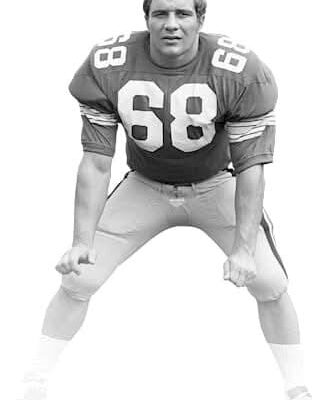From Three-Time Big Ten Champion to National Award Winner: The Incredible Ohio State Legacy of Jim Stillwagon, Rose Bowl Victor, Unanimous All-American, and Historic Outland and Lombardi Trophy Recipient.
Jim Stillwagon’s name resonates with power, pride, and excellence across generations of Ohio State football. As one of the most dominant defensive linemen in the history of college football, Stillwagon’s legacy is more than just his accolades—it’s about the leadership, toughness, and tenacity that defined a golden era for the Buckeyes. His three-year reign as a starter for Ohio State coincided with a period of utter dominance in the Big Ten and national college football scene. With championships, individual honors, and unforgettable performances, Stillwagon cemented his place not only in Buckeye lore but also in the pantheon of college football greats.
Arriving at Ohio State at a time when expectations were sky-high, Stillwagon quickly established himself as an irreplaceable force on the defensive line. He started during one of the most celebrated stretches in program history under legendary coach Woody Hayes. Stillwagon’s sophomore season in 1968 is the stuff of legend. That year, Ohio State went undefeated, culminating in a powerful 27-16 victory over the University of Southern California in the Rose Bowl. That win was more than a capstone—it was a coronation. With that Rose Bowl triumph, the Buckeyes were crowned national champions, and Jim Stillwagon had helped anchor a defense that would go down as one of the most formidable in the game.
The 1968 team has been remembered fondly as one of the most complete squads ever to take the field for Ohio State. Playing alongside other soon-to-be legends like Jack Tatum and Rex Kern, Stillwagon’s contributions were central to their perfect season. Though individual awards were limited for underclassmen at the time, those who watched him knew he was bound for national recognition. His impact went beyond the stat sheet; he disrupted offenses, forced game-changing plays, and brought a ferocious presence that galvanized the entire team.
In 1969, Stillwagon’s junior season, he began to receive the national attention he richly deserved. He was named a consensus All-America selection, one of the highest honors in college football, awarded to those considered the best at their position by multiple major selectors. That season, the Buckeyes once again captured the Big Ten title, extending their dominance over the conference. Stillwagon’s motor and football IQ made him a nightmare for offensive linemen. He combined power with speed, showing an uncanny ability to read plays and attack the backfield. Though Ohio State fell short of repeating as national champions, Stillwagon’s individual profile was soaring.
By the time he entered his senior season in 1970, Jim Stillwagon was no longer just a standout player—he was the heart and soul of the team. Serving as Ohio State’s co-captain that year, Stillwagon led not only with his performance but with his voice and presence in the locker room. Teammates looked to him for inspiration and energy, and he delivered week after week. That year, he achieved the rare feat of being a unanimous All-America selection—an honor bestowed only on those who are recognized as the absolute best at their position by every major selector.
But his 1970 season was even more remarkable for what came next. That year, Jim Stillwagon became the first-ever recipient of the Lombardi Award, established to honor the best college football lineman or linebacker. The award’s namesake, Vince Lombardi, was the epitome of excellence and discipline in football, and Stillwagon’s name being etched as the inaugural winner was a testament to his elite performance and unmatched work ethic. Winning the Lombardi Award placed him in a prestigious fraternity and validated what Buckeye fans and coaches already knew—Stillwagon was one of a kind.
In addition to the Lombardi, Stillwagon also claimed the Outland Trophy in 1970, awarded to the nation’s best interior lineman. Winning both the Lombardi and the Outland in the same season is a rare and extraordinary achievement. It underscored not only his dominance on the field but also his ability to perform consistently against the toughest competition. These awards weren’t given lightly. Voters were unanimous in their belief that Stillwagon had elevated his play beyond what was thought possible for a college lineman.
Stillwagon’s accolades did not stop at national awards. That same year, he was named Ohio State’s Most Valuable Player, a fitting recognition from those who knew his impact most intimately—his teammates and coaches. For a defensive lineman to win team MVP is rare in itself, and it speaks volumes about how central Stillwagon was to the Buckeyes’ success. His ability to elevate those around him, to set the tone for toughness and focus, made him a cornerstone of the team’s identity.
Beyond the trophies and the headlines, Stillwagon embodied what it meant to be a Buckeye. He played with intensity, honor, and an unshakeable drive to win. He represented the values instilled by Woody Hayes—grit, preparation, and playing for the team above all else. His leadership helped shape the locker room culture, turning potential into achievement and unity into championship runs. Stillwagon’s presence on the field was intimidating, but off the field, he was known as a humble, grounded individual who preferred to let his play do the talking.
After college, Stillwagon continued his football journey, but no chapter ever quite matched the brilliance of his Ohio State years. The foundation he helped build carried into future Buckeye teams, and his legacy was passed down as an example of what every Ohio State player should strive to become. The Big Ten titles in each of his three starting seasons were no accident—they were the product of meticulous preparation, passionate effort, and unrelenting commitment, all of which Stillwagon personified.
Today, Jim Stillwagon is remembered as a giant in Ohio State history. His jersey number may not be the most frequently cited among casual fans, but among die-hard Buckeye faithful and football historians, it carries immense weight. He didn’t just play football—he dominated it. His impact is still felt in the records, the highlight reels, and most importantly, in the culture of excellence that defines Ohio State football.
For any aspiring defensive player in college football, Jim Stillwagon’s story serves as a blueprint. He wasn’t the flashiest, but he was always the most dependable. He didn’t chase stats—he chased greatness. He didn’t demand the spotlight—he earned it. Whether he was leading the team onto the field as captain or disrupting an opponent’s game plan with another tackle for loss, Stillwagon left everything on the field. That kind of legacy doesn’t fade.
Jim Stillwagon’s journey through Ohio State was not just a college career—it was a symphony of excellence composed over three unforgettable seasons. From his early days helping Ohio State win a national championship in the Rose Bowl, to standing on award stages receiving the Lombardi and Outland Trophies, to being honored as a unanimous All-American, Stillwagon’s legacy is immortal. His name stands tall among the all-time greats, a beacon of what it means to give your all for the Scarlet and Gray.


